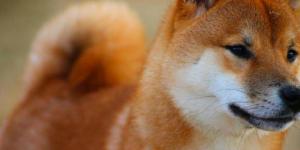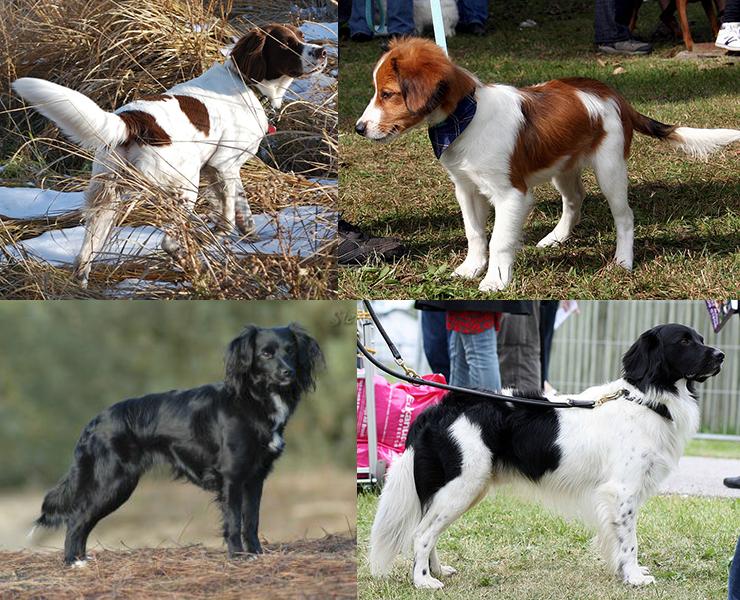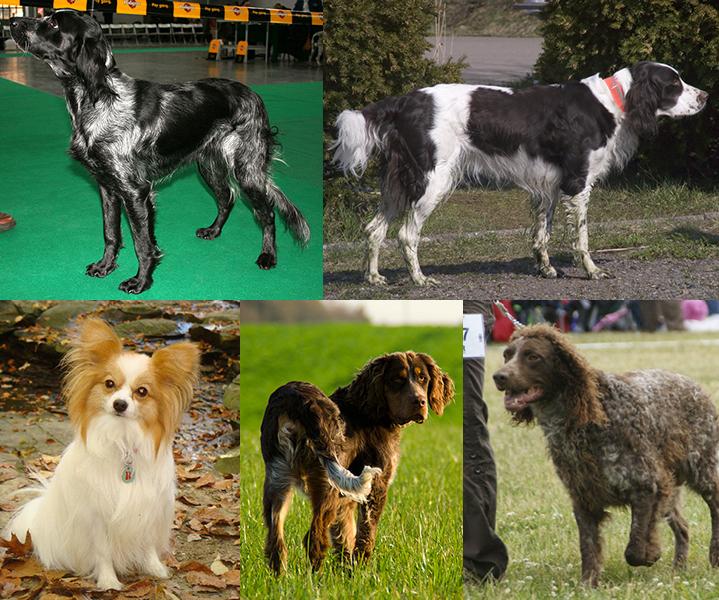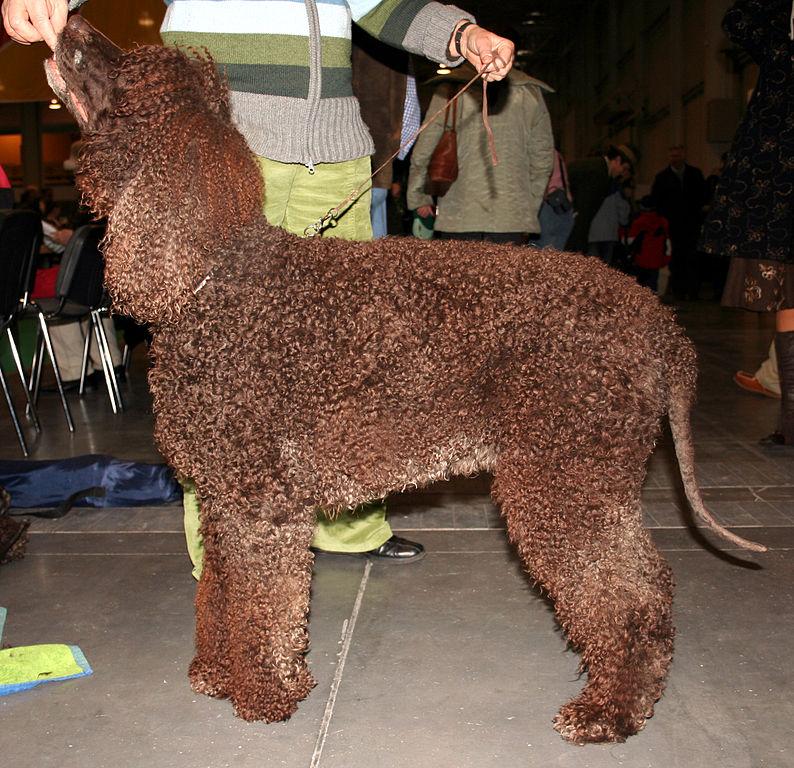Types of Spaniel Dogs: Spaniel Breeds Around the World



See files for Dogs
Have you ever wondered where do the different breeds of spaniel dog come from?
Spaniels were originally bred to be hunting dogs; more specifically, they were gun dogs, used to find and retrieve birds, not to kill them. Spaniels would work close to the hunter and provoke the birds - usually pheasants - to fly; once the birds were down, the spaniel would localize it by its scent and point their location with the muzzle.
There are many types of dogs that have been used as gun dogs, like Labrador Retrievers and Poodles, but spaniel breeds are particularly adapted to swamps, marshes, and thick brush lands.
In general, the main characteristics of spaniel breeds include: droopy ears, silky, long and wavy hair, and a medium to small size. The true origin of spaniels is unknown - they might have been first bred by the Celts, the Romans, or in the Middle East. However, they became popular in the 19th Century and local breeds of hunting, companion and show spaniels were established, all of them with notable traits.
Want to know more about the different types of spaniel dogs? Stay with us at AnimalWised and learn all about the many spaniel breeds around the world, geographically classified.
American spaniel breeds
American Cocker Spaniel
The American Cocker Spaniel and the English Cocker Spaniel (see below) are very similar, as they only differed due to the different breeding associations in the United States and the United Kingdom. In America, it is usually called simply "Cocker Spaniel".
The American Cocker Spaniel breed were kept as working dogs, as companions and assistants to hunters of wildfowl and as pets. They can serve both purposes because of their small size, at 34-39 cm (13 to 16 in) tall. Their coat can come in different colors, although solid black is a common variety.
The main difference between American and English Cocker Spaniels is their head, as the American variety has a; domed skull, noticeable eyebrows and a flatter muzzle. American Cocker Spaniels are intelligent and cheerful, and with proper socialization, they can get along with mostly anyone.
American Water Spaniel
This American spaniel breed descends from the Irish (see below) and the English (extinct) Water Spaniels; like them, the American Water Spaniel has a double, curly coat. It was first bred in Wisconsin in the 19th Century, where its fur allowed it to hunt and swim in cold weather.
This medium-sized spaniel, at 38-46 cm (15-18 in) tall, is almost always brown. Its ears are long and wide, like that of most spaniels. The American Water Spaniel is a rare breed, so there isn't much variety.
American Water Spaniel breeds are skilled, agile, versatile and very resistant. They love spending time with their family and usually have a favorite that they stick to. While very willing to learn, American Water Spaniels can be stubborn. They tend to suffer from ocular and dysplasia conditions.
Boykin Spaniel
This spaniel breed was created in South Carolina in the early 20th Century, specifically to hunt turkey. Since theIR territory can be quite swampy, this new spaniel breed had to be a good swimmer of small size.
Boykin Spaniels are 39-43 cm (15-17 in) tall, although they may appear more muscular and heavy. Their original habitat and climate also affected their coat, which is medium-length and can range from straight to curly. It is very important to clip and groom a Boykin Spaniel's coat, especially if it goes outdoors often.
The Boykin Spaniel is a very energetic, clever and steadfast dog; the require training and exercise to feel fulfilled, and plenty of socialization, as they are warm and loving. This spaniel breed has an extremely high probability of suffering from hip dysplasia.

British spaniel breeds
Most spaniel breeds and types were developed in Great Britain, where they were popular with the nobility both as companions and hunting assistants. Over time, however, some British spaniel breeds have become vulnerable native breeds and are part of a special watchlist.
Cavalier King Charles Spaniel
This British spaniel breed is extremely popular; it's closely related to the King Charles Spaniel, but their main health conditions, like the breathing difficulties brought by the flat muzzle, have been bred out. This attempt to breed a healthier King Charles Spaniel, like the 16th Century one, started in the 1920s.
Cavalier King Charles Spaniels are one of the small spaniel breeds; at 30-33 cm (12-13 in) tall, they are toy dogs . Their coat is silky, and it must be brushed weekly in order to keep it soft and shiny. This small spaniel breed come in different color combinations, but most commonly in shades of brown.
Like the King Charles Spaniel, the Cavalier breed is affectionate, eager and friendly; it's adaptable and good with children and other pets. However, they are not guard dogs and they require constant interaction. They are prone to; heart diseases, joint dysplasia and syringomelia.
Clumber Spaniel
This bigger British spaniel was a favorite with the royal family for many decades; it's among the largest spaniel breeds and is considered to be: strong, resistant and skilled at hunting wildfowl in harsh terrains. Sadly, nowadays the Clumber Spaniel is a vulnerable native breed in the UK.
Clumber Spaniels are heavy dogs, and they grow to 43-51 cm (17-20 in) tall. Their coat is flat and straight, unlike other spaniels, and it's very recognizable because of its white color and yellow, orange or brown freckle-like spots.
Although muscular and strong, Clumber Spaniels can be a bit lazy. They love carrying things in their mouths, which causes them to drool quite a lot. Clumbers are sensitive to heat and should stay in the shade. Clumber spaniel can also often experience difficult births, and therefore need heavy monitoring during the process.
English Cocker Spaniel
In the US, this breed is known as the "Cocker Spaniel". English Cocker Spaniels are popular dogs because of their intelligence and skill, which leads them to succeed in hunting - for woodcock, hence their name - obedience trials and shows.
English Cocker Spaniels are small, at 38-41 cm (15-16 in) tall; their body is compact and balanced. They are recognizable by their long ears, and their coat can come in different colors and combinations, although solid white Cocker Spaniels are rare. Here you can learn all about caring for an English Cocker Spaniel's coat.
This breed of spaniel is clever, alert and active, although cheerful and family-oriented; if you have an English Cocker Spaniel, you will have noticed how they have picked a favorite. This type of spaniel requires socialization and constant attention. They are prone to: dermal, eye and ear conditions. Rage syndrome, although rare, can occur, especially in solid golden English Cocker Spaniels.
English Springer Spaniel
This slightly larger type of spaniel was bred in the 19th Century; there are two kinds of English Springer Spaniels; those meant for shows, with soft coats and big ears, and those bred to work, with coarser and shorter coats.
English Springer Spaniels are strong and fast; they grow to 43-51 cm (17-20 in) tall, and they have a well-balanced body and a keen sense of smell. They are used as; police dogs, sniffers and in search and rescue missions. Their coat is usually; bi or multicolored, in white, liver and black combinations.
English Springers are friendly and obedient, but they are also very alert and have high energy levels, which means that they tend to get bored easily. They are prone to dysplasia and retinal atrophy, which is also common in other types of spaniels.
Field Spaniel
Unlike most British spaniel breeds, Field Spaniels were meant to be show dogs first and working dogs second. Breeders initially aimed to create an all-black spaniel, but they ended up with a dog that was slightly too short. Those height problems have since been corrected, but the Field Spaniel is still a vulnerable native breed.
Field Spaniels have a long, silky coat - usually in a solid color - that must be groomed regularly to prevent matting. They have no undercoat, which makes them susceptible to colds. These spaniels grow to 43-46 cm (17-18 in) tall.
They are very intelligent and independent, and they need specialized training - or at least a purpose or a job - to feel fulfilled. Field Spaniel are patient and friendly with children. This spaniel breed tend to develop ocular problems, as happens with most spaniels.
King Charles Spaniel
This well-known British breed is the result of the merging of different toy spaniels; the English Toy Spaniel appeared in the 16th Century, and was popular in the English court for centuries. King Charles II particularly adored this breed, thus they were named after him. There is in fact a famous royal spaniel called Dash, who was Queen Victoria's childhood pet. If you want to learn more about royal pets, take a look at our article on the Queen's dogs, with their names, history and fun facts.
Because of their small size and low stamina, the King Charles Spaniel is not a good hunting dog. These compact, long-eared dogs are even smaller spaniels than the Cavalier variety, at 23-28 cm (9-11 in) tall. They have large eyes and characteristic black skin around their mouth.
Over the centuries, toy spaniels were crossed with Pugs to obtain their characteristic flat muzzle; this brought about a tendency to: respiratory, ocular and cardiac problems, including a tendency to suffer from syringomyelia. The Cavalier was bred in an attempt to get back the original King Charles Spaniel's health and traits.
King Charles Spaniels are good lapdogs, with quiet and stable temperaments. Their main flaw is that they can get a bit too friendly and impatient.
Sussex Spaniel
This southern British breed was bred in the 18th Century, and it resembles the Clumber Spaniel, although they are a much smaller spaniel breed, at 33-38 cm (13-15 in) in height. Sussex Spaniels are stocky, with a thick and wavy double coat of a beautiful golden liver shade.
Sussex Spaniels have an excellent sense of smell. They are slow, calm and family-oriented, which makes them more quiet than other more excitable types of spaniels. The Sussex breed is prone to: herniation, dysplasia, heart conditions and ear infections. Today, they are sadly considered a vulnerable native spaniel breed.
Welsh Springer Spaniel
This breed, also known as the Welsh Cocker Spaniel, was almost lost to extinction and had to be re-bred in the 20th Century. Luckily, their numbers are currently growing, and they've become popular in dog trials.
Welsh Springer Spaniels are medium-sized and compact, at 43-48 cm (17-19 in) tall. They have characteristicwhite and red coats and floppy ears. They are sturdy and extremely loyal spaniel breeds, although they can be distrustful of strangers and do require training. They are prone to; hip dysplasia, ocular conditions and separation anxiety.
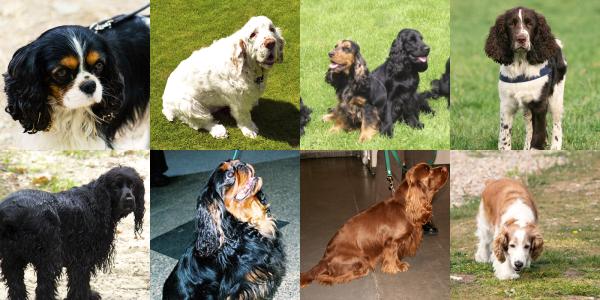
Dutch spaniel breeds
Drentse Patrisjhond Spaniel
The name of this Dutch spaniel breed comes from the word "Drent", meaning "partridge". This is because this type of spaniel was bred in the 16th Century to hunt fowl in fields and marshes. However, Drentse Patrisjhond were not exclusively for the nobility and they therefore trained in all sorts of functions.
The Drentse Patrisjhond is a large spaniel breed at 55-63 cm (22-25 in) tall, but it's not as heavy as the Clumber Spaniel. Their medium-length coat is white with brown or orange patches.
Drentse Patrisjhonds are driven, reliable and very loyal dogs who can run quite fast. They will be able to relax in a home, but they need to exercise and to be able to enjoy the outdoors.
Kooikerhondje Spaniel
This adaptable Dutch spaniel was originally bred to work on farms; Kooikerhondje were specialized in hunting ducks, but they are very adaptable. This Dutch spaniel breed is cheerful, friendly and attentive; however, it can be mistrustful of strangers, as it is very alert.
Kooikerhondje Spaniels are about 36-41 cm (14-16 in) in height, and they are white and orange, with a beautiful plumed tail. They have the same health issues as other spaniels and need regular exercise as they tend to gain weight easily.
Markiesje Spaniel (Dutch Tulip Hound)
The origins of this Dutch breed go way back, but the Markiesje Spaniel as we know it in modern days was bred just decades ago. Their size is the same as the Kooikerhondje Spaniel, and they also need exercise to channel and get rid of excess energy.
The Markiesje Spaniel is an alert, watchful dog that can be an excellent guard dog; if you mean to keep a Markiesje as a companion dog, you'll need to socialize it well.
Stabyhoun Spaniel
Sadly, the Stabyhoun Spaniel is a very rare Spaniel breed. The Stabyhoun originated in Friesland in the 19th Century, when it was kept in farms to catch vermin, drag carts, track hunting prey and retrieve it; as a farm dog, the Stabyhoun Spaniel is extremely adaptable, obedient and agile. It's especially useful as a retriever dog, as it never damages or hurts what it catches.
Stabyhoun Spaniels are relatively large at 50-53 cm (20-21 in) tall. They have a long, balanced body with big feet; their coat is very sleek and soft, usually in black and white, although they can have some brown. Stabyhouns do shed, so they will need regular brushing to prevent mats and tangles.
This Spaniel breed is notable because of its cleverness and good temperament. Stabyhoun Spaniels are tolerant of others and gentle, although they do have an independent streak. They tend to have good health and long lives, which explains the recent expansion of the breed.

French spaniel breeds
Blue Picardy Spaniel (Épagneul bleu de Picardie)
This rare Spaniel breed appeared in France, in the region around the river Somme, in the 20th Century. Experts believe that the Blue Picardy Spaniel descends from the Picardy Spaniel (see image below) and the English Setter, although there was probably influence by different local types of French Spaniels.
The Blue Picardy Spaniel is quite large for this type of dog, at 56-61 (22-24 in) tall, although its height mostly comes from its long legs. Its name comes from its gray or black soft, wavy coat with blue shades.
Blue Picardy Spaniels are quiet and loving, but they have high energy levels and require lots of exercise. Like most long-eared spaniels, they are prone to ear infections.
French Spaniel (Épagneul Français)
The French Spaniel is probably the oldest spaniel breed in France, as it was mentioned in medieval texts. This Spaniel breed was also bred in Canada, and it's also known by the names of "French Setter" and "Canada Setter". They were used to hunt, specifically wildfowl in woods.
French Spaniels are the tallest of all the types of spaniel at 56-61 cm (22-24 in) tall, with a strong, muscular body. Their coat is usually brown with black, brown or liver spots, and they have long ears.
A French Spaniel is known to be friendly and obedient, and it can become an extremely caring and loyal friend. This breed needs to receive regular exercise and is generally considered to be quite healthy except for some dermal diseases like acral mutilation and analgesia.
Papillon and Phalène Spaniels (Épagneul nain continental)
This old French breed is also called "Continental Toy Spaniel". Their name, "Papillon" and "Phalène", means "butterfly" and "moth"; they fall under the same breed, but they get different names depending on their ears.
Phalène Spaniels are older, as we can see them represented in some Renaissance Paintings. They were popular lapdogs among the higher classes. In the late 19th Century, a variety with symmetrical, upwards ears was bred; because of the shape of their ears, they were called Papillon Spaniels.
Papillon and Phalène Spaniels come in many different colors, and they are considered very small spaniel breeds, at 20-28 cm (8-11 in) tall. They are sensitive to the cold, because they only have a single coat. Depending on the dog the tail may curl over like that of a squirrel. Papillon and Phalène Spaniels are considered to be: high in energy, intelligent and alert dogs that can be aggressive if they aren't trained properly and/or given the right amount of exercise.
Picardy Spaniel (Épagneul picard)
The Picardy Spaniel is among the oldest of all French spaniel breeds, together with the French Spaniel; however, nowadays their presence is quite rare. The Picardy Spaniel was bred by the social elite as a an adaptable, fast dog; able to hunt in different terrains, from swamps and marshes to woods.
The Picardy Spaniel is as large as the Blue Picardy variety. It has a muscular, proportionate body covered by a grayish brown coat with occasional white spots. Its muzzle and ears are quite long.
Picardy Spaniels are notable for their good health, although they also tend to suffer from ear infections. They like playing in the water, but they adapt well to living in cities as they are gentle, docile and playful.
Pont-Audemer Spaniel (Épagneul Pont-Audemer)
This 19th Century French spaniel breed is quite a rare breed that descends from the French Spaniel crossed over with different types of water-loving spaniels. The Pont-Audemer Spaniel is a fun-loving and affectionate breed.
Pont-Audemer Spaniels are relatively large at 50-58 cm (20-23 in) in height. Their brown and white coat is wavy to curly except for the face, where it is smooth; they might develop alopecia problems at some point in their lives. Their muzzle is notably pointed.
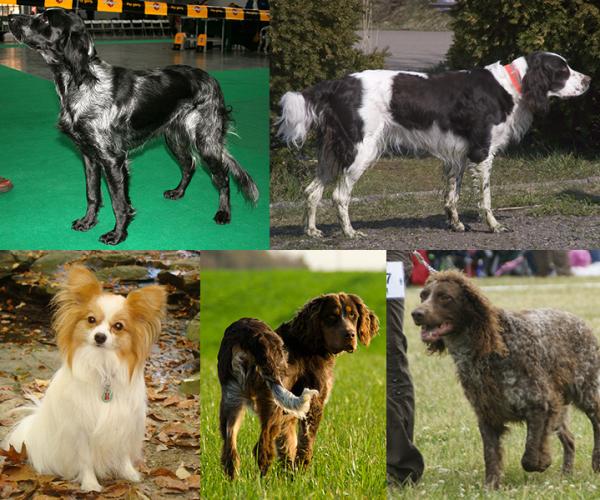
German spaniel breeds
German Spaniel (Deutscher Wachtelhund)
The name of this German spaniel breed means "quail", as the German Spaniel was used to hunt quails . The modern Deutscher Wachtelhund comes from a long line of versatile hunting dogs, and its main ancestor was the Stoeberer.
German Spaniels have long, thick brown coats with white spots,occasionally ticked. They are 46-53 cm (18-21 in) tall, sporting a; strong, long and solid build. Their ears are long and they have an incredibly strong sense of smell, making them excellent tracker dogs.
German Spaniel breeds are considered brave and friendly, but can sometimes be too driven. They are rarely kept as pets, but used more for hunting.
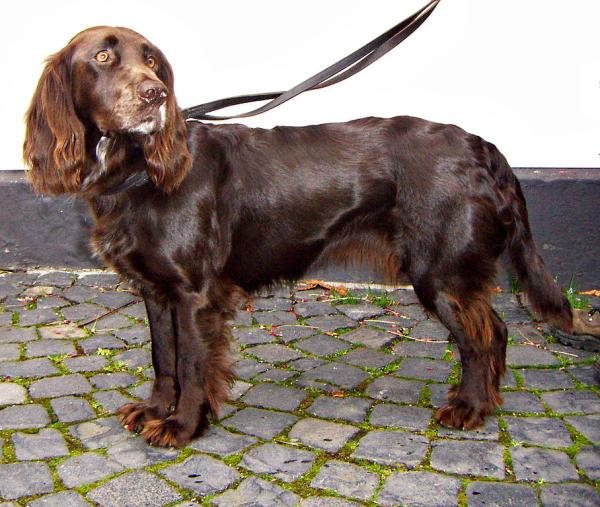
Irish spaniel breeds
Irish Water Spaniel (An Spáinnéar Uisce)
This native Irish spaniel breed has a an incredibly long history; there is no record of this beautiful dog's origins, but they appear in folklore and they look remarkably different from all the other types of spaniel.
The most notable aspect of the Irish Water Spaniel is its coat; it is extremely curly and of a liver coloring that can shine purple depending on the light. The Irish Water Spaniel barely sheds, so it's often included in hypoallergenic dog lists. The tip of its tail, interestingly, is hairless. Irish Water Spaniels need to be groomed to prevent matting, but this is an easy process.
Irish Water Spaniels are large, at 56-61 cm (22-24 in) tall. They have a square, sturdy build, and are good swimmers - they even have webbed feet. This is a keen, active and energetic, spaniel breed that it needs regular exercise. Irish Water Spaniels are very clever and eager to help, and unlike most other spaniel breeds they can be good guard dogs as they have a very strong and distinct bark. However, they need to be properly socialized.

Russian spaniel breeds
Russian Spaniel (Rosyjski)
The Russian Spaniel is quite a modern spaniel breed, as was developed in the Soviet Union in the mid-20th Century from a mixture of other spaniel breeds. It was used to hunt in difficult terrains like woodlands and marshes, but they are currently very popular pets in Russia.
Russian Spaniels are small spaniel breed, at 38-43 cm (15-17 in) tall, with a long, sturdy body. Their coat is short but silky, and it comes in different solid colors and color combinations, although their long ears tend to be darker than the rest of their body. Like most types of spaniel, the Russian Spaniel tends to obesity and ear infections, and it needs regular exercise. It is an easy-going, fun breed.

This has been a round-up of the different types of spaniel dogs: Spaniel breeds around the world. Have we missed your favorite spaniel breed? Tell us in the comments section!
If you love this type of dog, check out the following articles:
If you want to read similar articles to Types of Spaniel Dogs: Spaniel Breeds Around the World, we recommend you visit our Comparisons category.



